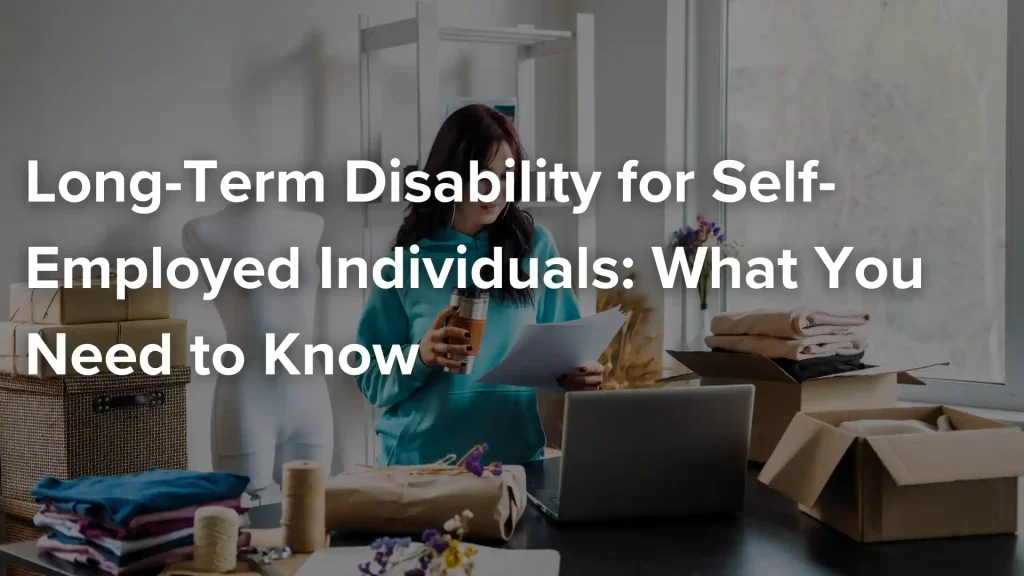Posted on Sunday, June 22nd, 2025 at 9:00 am
 If you’re self-employed, you already juggle a lot—clients, operations, and income stability. What happens if you become too sick or injured to work and unable to work? Unlike traditional employees, you don’t have the luxury of a company-sponsored disability plan. That’s why understanding long-term disability for self-employed workers is so important. If you can’t work, LTD benefits may be the key to protecting your income and your future. This is especially true if you’re your own boss—disability insurance for the self-employed can be a crucial safety net, offering financial stability when illness or injury prevents you from running your business.
If you’re self-employed, you already juggle a lot—clients, operations, and income stability. What happens if you become too sick or injured to work and unable to work? Unlike traditional employees, you don’t have the luxury of a company-sponsored disability plan. That’s why understanding long-term disability for self-employed workers is so important. If you can’t work, LTD benefits may be the key to protecting your income and your future. This is especially true if you’re your own boss—disability insurance for the self-employed can be a crucial safety net, offering financial stability when illness or injury prevents you from running your business.
How Long-Term Disability Works for the Self-Employed
Unlike W-2 employees, self-employed people must purchase their own long-term disability insurance, typically called an individual disability income plan. These plans are sold through private insurance companies. There are many policy types available. Some are tailored for freelancers, while others are marketed as entrepreneur disability protection or business owner disability insurance needs.
If you haven’t bought a plan, now is the time to explore your options. If you already have coverage, knowing how it works is essential if you ever need to file a self-employed LTD claim.
What LTD Insurance Covers
Long-term disability insurance typically replaces a portion of your income (generally between 50% and 70%) if you can’t work due to illness or injury. Depending on your chosen terms, policies can pay benefits for several years, up to retirement age.
Your eligibility depends on your policy’s definition of disability. Some plans require that you be unable to perform any occupation, while others offer own-occupation coverage. Own-occupation coverage pays benefits if you can’t do the specific work for which you were trained. That distinction is often critical for high-skill freelancers, surgeons, consultants, or creative professionals.
Income Documentation
Income verification can be tricky, especially if your business revenue fluctuates. Tax returns, profit and loss statements, and business bank records can all help demonstrate your past income. For a successful long-term disability claim for business owners, you must prove:
- Your medical condition prevents you from working
- You had valid coverage when the disability started
- You were earning income from your business
Tax Considerations for LTD Benefits
Are LTD benefits taxable? The answer depends on how you paid your premiums. If you paid your self-employed short-term disability insurance premiums with after-tax dollars, your benefits are generally tax-free. But if you deducted those premiums as a business expense, your benefits may be taxable.
This is a significant issue. While deducting premiums can reduce your short-term tax bill, it may create a surprise down the road. Speak with a CPA or tax advisor for advice before choosing how to handle them.
LLCs and S-Corps
If you run your business through an entity, like an S-Corp or LLC, ensure your policy is correctly structured. You’ll want to avoid situations where the business owns the policy, but you personally become disabled. Ownership of the policy affects both your benefit eligibility and how benefits are taxed. Missteps in structure could delay or reduce your benefits.
Choosing the Right Disability Policy
Not all disability policies are the same. When you’re shopping for a freelance LTD policy, consider these features:
- Own-occupation coverage: These policies pay if you can’t work in your specific profession. If you’re in a specialized field, this type of coverage is a must.
- Residual or partial disability benefits: These policies offer partial benefits if you can only work part-time or earn less than before.
- Non-cancellable and guaranteed renewable: This prevents insurers from dropping you or raising rates if your health changes.
- Benefit period: Choose how long you want your benefits to last, such as two years, five years, or until retirement age.
Elimination Periods
 Every LTD policy has an elimination period (typically 60 to 180 days) before benefits begin. Make sure you have savings or short-term disability coverage approved to fill that gap. If you wait until you’re already ill or injured, you likely won’t qualify for a new private disability policy. It’s best to apply while you’re healthy.
Every LTD policy has an elimination period (typically 60 to 180 days) before benefits begin. Make sure you have savings or short-term disability coverage approved to fill that gap. If you wait until you’re already ill or injured, you likely won’t qualify for a new private disability policy. It’s best to apply while you’re healthy.
Ultimately, the research you put into your disability policy now will pay off in the future, should you ever need to use it. Whether temporary or long-term payments are necessary, your livelihood will be protected.
Get Help Filing or Appealing Long-Term Disability Claims with Capitan Law
Your ability to work is your most valuable asset. If illness or injury takes that away, long-term disability policies in Philadelphia for the self-employed can provide vital financial support.
Capitan Law helps freelancers, entrepreneurs, and business owners across the U.S. protect what they’ve built. Our team is here to help you understand your rights and take the first step toward securing the necessary benefits. Contact us today at (267) 419-7888 to speak with a disability attorney who understands self-employed professionals and their unique insurance benefit needs.
Related Post
Watch Out for Limited Coverage Conditions and Hidden Policy Surprises